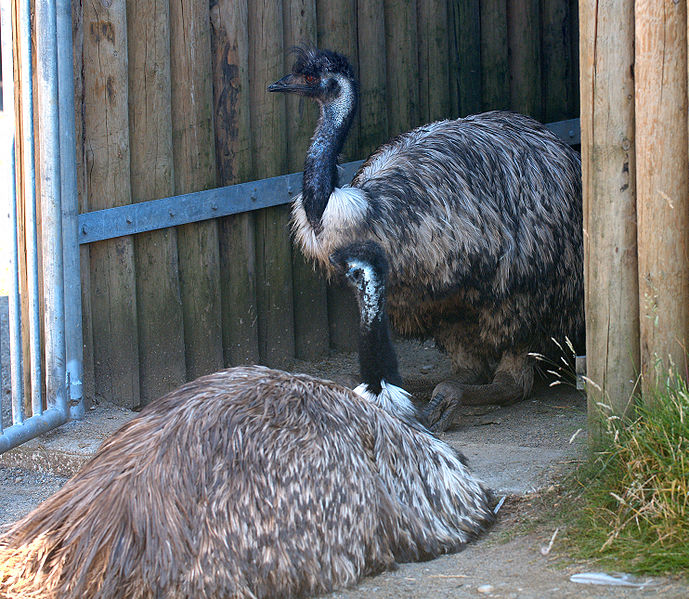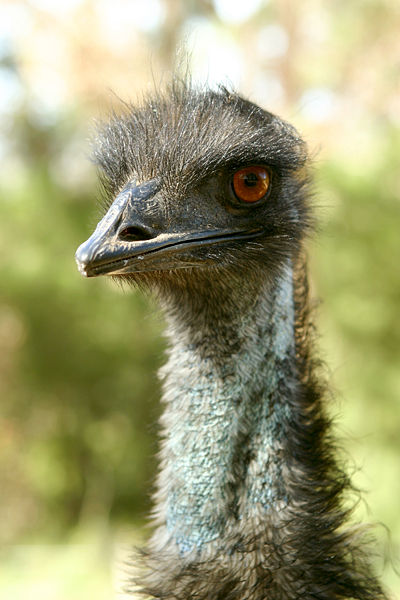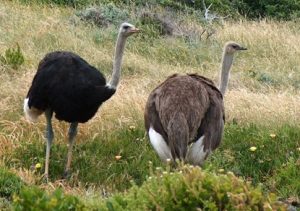Ratites
Ratites are a diverse group of five flightless birds and as a consequence, they have no keel on their sternum (breast bone). The emu and cassowary are native to Australia and the latter is also found in Papua New Guinea. The small kiwi bird weighs 1.2 kg to 3.3 kg and is found only in New Zealand. The ostrich is native to Africa and the rhea is native to South America and is found mainly in Argentina. Only the emu and ostrich are farmed in Australia.
Emus

Emus are farmed for their meat, leather, oil and egg shells. Photo courtesy of Wikimedia Commons
Emus (Dromaius novaehollandiae) stand almost two metres tall and can weigh 40 to 50 kg at two years of age. Emus are found in a wide range of habitats and feed on berries, seeds, nuts, seedlings and insects. Their digestive tract is much shorter than that of the ostrich but it appears to still allow them to effectively digest fibrous feeds. Their feed requirement for maintenance is low compared to the domestic fowl when compared on a per kg or metabolic body weight basis. They can survive in the wild for several weeks without feed and water.
The laying season starts in early winter, and the female lays an egg every 2-3 days in a clutch of about 10-12 eggs (450 g) and may do this several times a year. The male incubates the eggs, which hatch out in 56 days. He may care for the chicks until several months old. The chicks have characteristic coloured stripes which start to disappear at 12 weeks of age. The Australian Aborigines ate the eggs and emu meat as part of their diet.
As Emus are flightless, and because they have no keel on their sternum, the lean, red meat is in the thighs and rump. The Aborigines prized emu oil for its medicinal benefits. Typical carcass yield (% of live weight) is 47%, cut up meat 32% and fat 19%.
Emu Farming in Australia
Emu farming started in Australia in the 1980s. Ironically there are more emus farmed outside Australia than within, particularly in North America. They are farmed for their meat, leather, oil and eggshells (which can be decorated) and some of these products are in direct competition with the ostrich industry. There has been an increased focus on emu oil and it is now marketed in a wide range of products. These range from skincare to anti-inflammatory products and for example can be taken in capsule form as a remedy for arthritis. It is not known if the value of these products is related to the emu’s diet, which is somewhat different in the wild to that when farmed. Emu leather is used for accessories such as shoes, gloves, handbags and so on, however, it is not as robust as ostrich leather. The average yield is about 0.7m² and skin thickness varies from 0.5-0.6 mm.
In 1997 there were 1,330 registered emu farms holding 103,000 birds. This dropped sharply to 149 farms carrying 45,000 birds in 2001. Between 2001 and 2004 emu farming went into a further decline but recovered in 2004 when over 6,000 birds were slaughtered with an estimated value of $1m. Meat production was 75 tonnes, then fetching about $16.0/kg and emu oil production was 38,000 litres – about $40.0/L to the producer. A lively export market was established and in 1996, 43 tonnes of emu meat was exported but this declined to zero in 2000. There is little doubt that the emu industry is continuing to contract. In some states, commercial farming has ceased due to the difficulty in getting birds to appropriate processing facilities.

Emu farming in Australia started less than 30 years ago. Photo courtesy of Wikimedia Commons
The birds aged one year are shorn before killing and the fat under the skin is removed which yields about 6-7 kg of oil. The drumsticks produce about 3.5 kg of meat and the thigh cuts (rump and fillet) about 5 kg. These are the favoured portions through restaurants and gourmet butchers but much of the meat is further processed into sausages, salami, meat pies, pate etc. These products may sometimes be found in farmers markets, especially emu sausages in a sausage sizzle. A single bird can be expected to produce on average 10 to 12 kg of meat and 10L of oil. With current commodity prices, the value of a single emu at slaughter is approximately $575 to $600 Australian dollars. All emu eggs laid are usually set for hatching. No eggs are sold for domestic consumption. A very small number are sold for art and craft or tourism purposes.
Incubation of eggs and rearing of emus requires skilled management. Birds cannot be taken from the wild and normally the eggs are placed in a special incubator. There are strict government guidelines as to how emus are housed, managed and fed with emphasis on welfare (QLD Department of Primary Industries website). A perimeter fence of at least 1.8 m ensures good biosecurity.
Mortality of chicks is 7 to 12% up to 3 months of age which can be due to aspergillosis starting at 3-8 weeks of age, for which there is no effective treatment. Salmonella can also be a problem in chicks over two weeks of age. Treatment is with antibiotics but it is almost impossible to eliminate these diseases from the farm. In cases, good management and reduced dust levels are essential. Special attention to hygiene, particularly in handling and storage of eggs and fumigation of the incubator, is essential in the control of salmonella outbreaks.
Ostriches
If you happen to visit Oudtshoorn in the Little Karoo, you will notice several substantial houses, known as ‘Ostrich Palaces’ built at the end of the 19th century. These large, privately-owned houses were funded by the highly profitable South African ostrich industry, not then from the sale of hides and meat, but from feathers for the world’s fashion industry. The dry, arid region of the Little Karoo is still the centre of the South African ostrich industry although it has diversified to other regions of the country, mainly for bird health reasons as heavy concentrations of livestock often result in disease problems.
There were about one million commercially-farmed ostriches by 1913 until the war broke out. Sanctions imposed against South Africa in 1986 put an end to the hide export market, then 96,000 hides per year to the US. This gave the opportunity for other countries to establish ostrich farming.
In 2007, of the 350,000 birds slaughtered worldwide, 257,000 were grown in South Africa. Recent average price per bird received by the farmers was $186 USD and of this, 67% was the hide, 29% meat and 4% feathers. Although hide and meat prices fluctuate.
The ostrich (Strutho camelus) is up to 2.4 m tall, can weigh over 100 kg and is a native of sub-Saharan Africa. It can travel at 70 km/h and withstand temperatures of up to 55oC without any apparent hardship. The female can start laying, at two years of age, clutches of 20 to 24 eggs and up to 80 to 100 eggs in one season (July to March). There are four products: leather, meat, feathers and egg shells for decorating. The gift shop in Oudtshoorn has many other ostrich ornamental products. The fashion for feathers has long gone and they are now mainly used in feather dusters.
In theory, the ostrich industry looked like an attractive and profitable proposition. Of the 80 eggs laid and hatched in 42 days, 40 ostriches would be slaughtered, assuming good management. They should yield 1,800 kg of very low fat, low cholesterol meat, 52 m² leather and 36 kg of feathers. One of the difficulties has been that the most economical slaughter age for meat was earlier than the age for best quality leather. This has recently changed as ostriches can now achieve 95 kg at 10 months of age. The ostrich is not really domesticated and is difficult to manage and handle. It is not uncommon to raise only 10 to 15 birds per hen per year to market weight. It requires excellent management skills and accurate record keeping. As a consequence, the ostrich industry has been through torrid times over the past since the 1980s.
The Australian Ostrich Industry
Ostriches were imported into South Australia at the end of the 19th century. However, they were later released into the wild and in the 1980s were recaptured and used as the foundation stock for the commercial ostrich industry. They were mainly of inferior genotype but that did not seem to matter and the industry was so buoyant that pedigree was of little consequence and a pair of proven breeders fetched up to $70,000.

As a consequence, a few made a fortune and many lost their savings particularly when the industry switched from the breeder phase to the commercial phase. Special incubation, slaughtering, transport and handling facilities had to be established for an industry now scattered widely across the continent. The ostrich industry was also becoming established in many countries, especially the US, Canada, Israel, France, China, Zimbabwe and Namibia and superior genetic material was imported into Australia. This included the African Black, the Zimbabwean Blue and the Kenyan Red.
At this stage, it became clear that ostrich meat had to compete with other red meats which were then comparatively cheap. As a consequence, the average price to the producer in 2002 was only $5.82/kg but has increased to $13 /kg in 2009; 72% of the meat was exported, mainly to the US. The number of Ostriches slaughtered declined from 21,400 in 2002 to 6,200 in 2007 and was valued at $1.7 m. An outbreak of Newcastle Disease in the Australian poultry industry around this time meant that ostrich meat could not be exported to the European Union, which was by then the main market. Drought conditions also impacted the industry and the few producers remaining are now just maintaining breeding stock. However, there are good export opportunities with exceptionally high prices for meat into the US, Canadian and Japanese markets, as the first two do not now allow the importation of meat from South Africa. Salted skins are sold mainly to Israel and Korea, although a few are tanned in Victoria. The requirements for a grade-A hide are very stringent and the tanning process was a well-kept secret but the technology is now more common outside South Africa. The attractive hides, with their distinctive quill patterns, are tanned for the French, Italian, Japanese and North American markets where they are made into shoes, boots, wallets, belts, handbags, jackets etc.
As a result of a judicious breeding program, the growth and quality of leather have improved and is sought after particularly by Italian manufacturers who are leaders in ostrich leather products. Adult ostriches are kept in pairs or one male to two females in a small enclosed paddock (minimum 625 m²) with a shelter and given a formulated breeder feed. There is now a move to keep much larger numbers, up to 100 birds, in a paddock where cocks of the same linemate with hens of a different line. Eggs are collected from a depression in the ground and stored until placed in an incubator. The chicks hatch out in 42 days and are held in an enclosure with a heat lamp and a non-slippery floor (e.g. rough concrete, slip-proof material) or mesh wire where they are given a starter diet. Hatchability of all eggs set is 60 to 70%. The chicks have egg sac reserves for about six days, but it is sometimes difficult to persuade them to drink and to entice them to feed as they are attracted to colours and shapes. Heat must be provided and an outside run. During this phase, chick mortality to 13 weeks is about 14%. They are fed a specially formulated feed or sometimes a turkey starter diet is provided. Compaction of the gizzard is not uncommon in the young bird due to eating coarse or foreign material. Provision of coarse sand is important for gizzard function. Disease is prevalent as the chick collects droppings from other birds and cleanliness is a priority.
Young ostriches are held in large groups and fed formulated diets, usually with access to an outside pen with good pasture. Exercise is very important as leg rotation and deformed hocks are common. This seems to be, in part, a genetic disorder and has been reduced through selection. The very special digestive tract of the ostrich, with long caeca, allows it to digest fibre very efficiently. In some cases, adult birds can be maintained on high-quality chopped hay, especially lucerne, and on pasture if of good quality. Feeding ostriches on compounded feed can be expensive as they do not convert feed to gain efficiently, particularly during the last two months of growth. Adult ostriches are hardy and don’t often suffer from disease. In young birds, particularly in wet, humid environments, aspergillosis can infect the lungs. The fungi spread easily as the spores are wind-borne and there is no known cure.
Information provided by Dr David Farrell.

